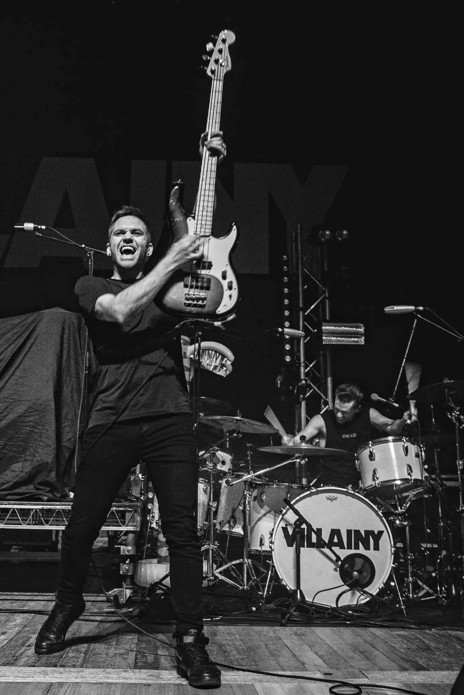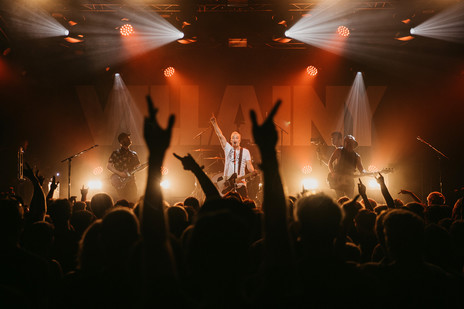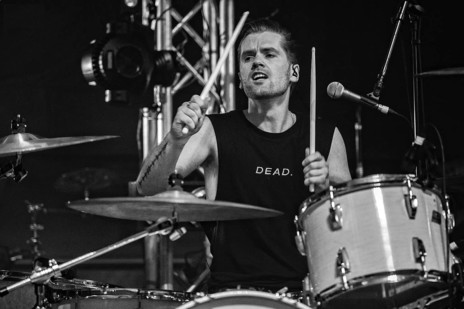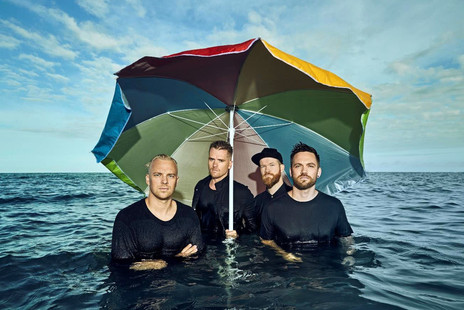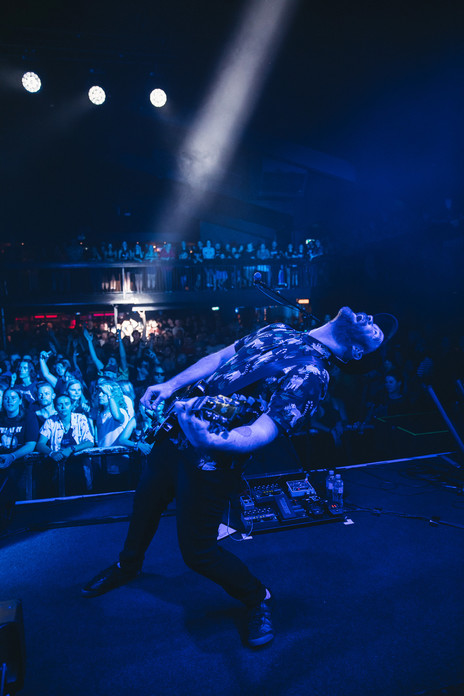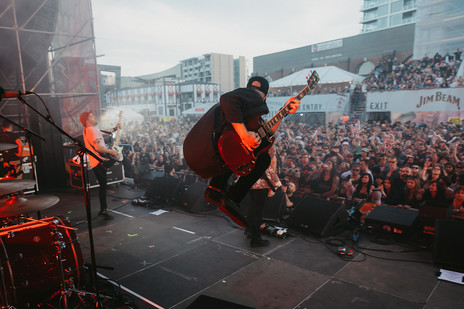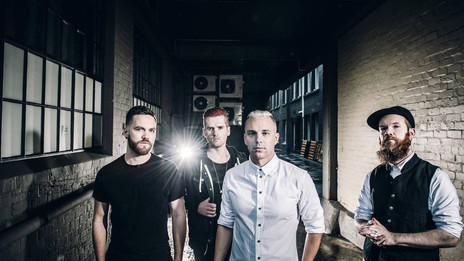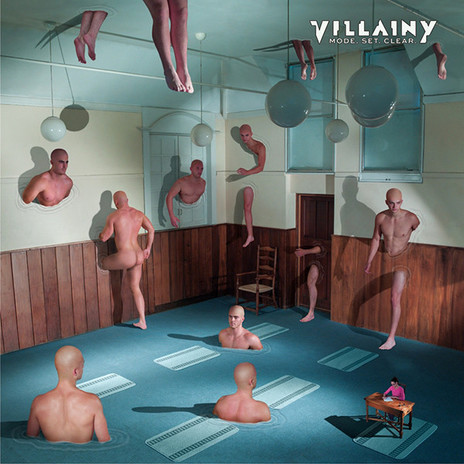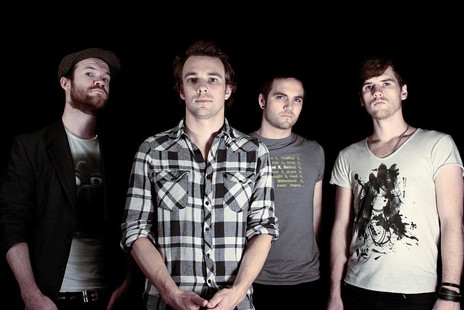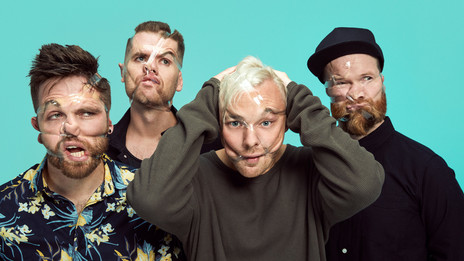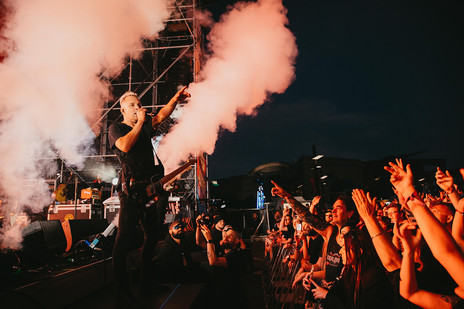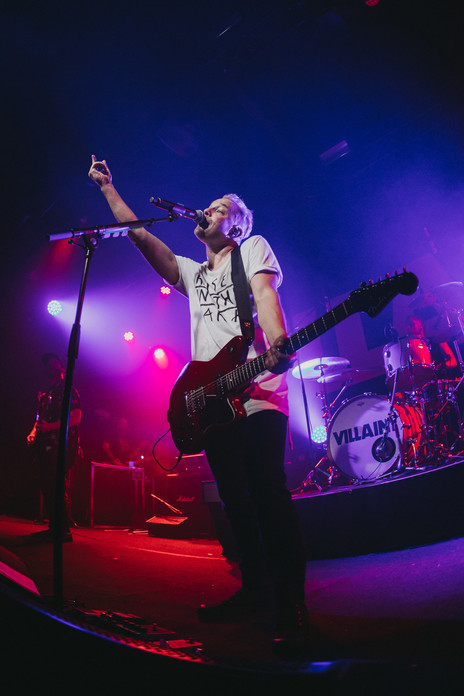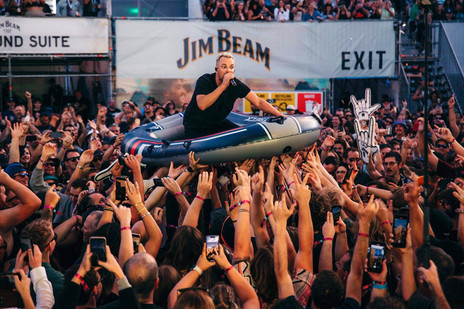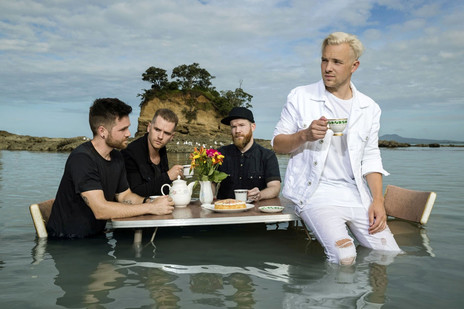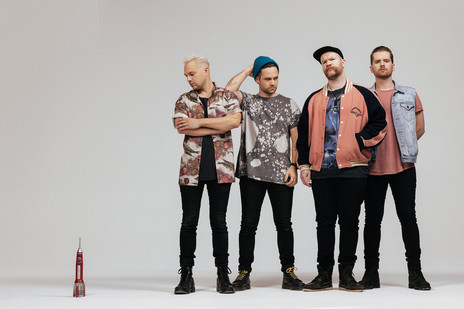Inverse Order’s Six EP (2008) was recorded with drummer Tristan Lewis and showcased their emotive alternative-rock sound, as evidenced by the singles ‘Better Not’ and ‘Quell’.
“We wanted to clean the slate and go – here’s this new band with a new identity: Villainy.”
Fraser admits they had trouble getting things going. “We dropped the EP, but didn't really know how to market it properly. Everyone was on MySpace and it was a weird world of music promotion long before streaming etc became the norm. But it kind of petered out after a while and we thought ‘now what?’ Things solidified when our bass player introduced us to Dave Johnston in 2011 to play drums. We'd gone through lots of different drummers, but with Dave things really clicked. We started working on a new batch of songs. It felt like the band really had a much clearer direction and so it made sense to rename ourselves. We wanted to clean the slate and go – here’s this new band with a new identity and we're gonna call it Villainy.”
Mode. Set. Clear.
Villainy arranged to record with producer Tom Larkin (Shihad) at his “The Studios In The City” recording space in Brunswick, Melbourne. Modern rock wasn’t flavour of the month at that time, after the 00s trends of pop punk, emo, and retro rock had fizzled out and the decline of electric guitar sales had seen music journalists speculating about the “death of rock”. This left Villainy with a lane to themselves, following on from the heavier end of the 90s alternative-rock sound. In some ways, it was similar to Shihad’s approach, which is why Larkin was the perfect producer. He knew how to get a monstrous sound out of a four-piece band without muddying the vocals.
At one point, Villainy were rehearsing their new song ‘Alligator Skin’ at the Killing Room practice studios in Kingsland when former Exponents singer Jordan Luck suddenly wandered into the room. He told them he’d overheard them playing and felt compelled to tell them that the song they were playing was a winner.
Fraser saw the song go through several iterations before the parts fell into place. “James came up with the idea of putting a drum’n’bass style drumbeat behind it. We demoed it up as a bedroom demo with electronic drums and then I wrote a few lines. We liked that it had a chant-like aspect to it. Once we had that to glue it all together, we were able to work on it in the band room. Not a lot was changed from the original demo, but all the elements really clicked playing it as a band. When we released it, we thought it would be a good taster song to get people interested. Instead, it ended up on the Radioscope airplay charts for over a year, so it definitely took on a life of its own that we didn't quite expect.”
The opening bars of the song were in 7/8 time, which gave the riff an intriguing asymmetrical rhythm, before the verses switched to the standard 4/4. The single dropped in May 2011 and the resulting buzz led to them supporting Incubus arena shows the following year. They also undertook their own national tour with Luger Boa and Clap Clap Riot, building their name while they completed their album.
For the ‘Mode. Set. Clear.’ album, Their aim was a polished, radio-ready sound
Their aim was a polished, radio-ready sound so they carefully laid down each individual part with an ear for detail. They had already amassed 20 songs, including a few Inverse Order tracks that were five years old, as Fraser recalls:
“The songs that had been kicking around since the Inverse Order days went through some pretty big transformations. One of the main things for us was figuring out how to write a sick rock song and still have a poppy hooky chorus … Tom Larkin really helped us learn how to be a band. We had no idea about producing music – how you play instruments in a studio environment. He’s been working with different bands for so long that he has an incredible grasp of what makes a great rock song; or what makes a great song in general. More broadly, he’s got a lot of experience in the industry and has a really creative mind. He is really able to conceptualise things properly – whether it’s an album cover or a music video. He got us thinking about what will resonate and what will be different and interesting.”
The album Mode. Set. Clear. arrived at the end of October in 2012 and raced to No.8. The title was taken from the song of the same name – which was about a personal desire to find a clean slate – though it also fit perfectly with their decision to start over, with a new name.
The album’s cover art shows a surreal image, with a repeated bare-skinned figure emerging from the walls, floor, and ceiling, as if he is walking through it like liquid while in the bottom corner a tiny figure sits at a desk. It was created by Storm Thorgerson (1944-2013), who previously created famous cover designs for Pink Floyd, Led Zeppelin, 10cc, Bad Company, Al Stewart, Muse, The Mars Volta and many more. Villainy’s music extended from the quiet-loud thrust of ‘Gather Yourselves’ through to mid-paced numbers like ‘Another Time,’ which relied more on slow-building drama. Both were incredibly popular on local rock radio and thrust them to the forefront of the rock scene.
“WE HAD TO WORK OUT HOW TO CONNECT WITH AUDIENCES WHO DIDN’T KNOW US”
They joined Blacklistt for a 12-date tour of New Zealand, which included a few difficult shows. At Refuel Bar in Dunedin, the stage power cut out twice while they were playing and Fraser’s overzealous attempt to jump off the drum kit led to him tumbling forward off the stage, damaging both his guitar and his face. He nonetheless has happy memories of the tour:
“We were just figuring out how it worked. We hadn't really been on the road much outside of Auckland, so we had to work out how to connect with audiences who didn’t really know us. Touring for very little money can still be a lot of fun when you’re in your 20s and it’s really novel, but I look back at it now and think – what the hell were we doing? One time we finished a show at the King’s Arms in Auckland and jumped in the van with 12 people to drive overnight to Wellington ... After that we did some really memorable shows like playing at the last Big Day Out and supporting Incubus. Then there’d also be times when we’d end up just playing to 30 people at Mount Maunganui. That’s just reality in New Zealand. We're a little country and sometimes you can do these crazy huge shows and sometimes it's the total opposite.”
Dead Sight
Villainy also did their first slot at Homegrown in Wellington and made their first trip overseas, performing at the Big Sound music industry conference in Melbourne. They later returned to Melbourne to record again with Larkin. The band were keen to keep things fresh.
“We made a conscious decision that we wanted a very distinctive tone,” Fraser recalls. “Tom's engineer Samuel K. Sproull figured out how to create distortion through the preamps which created a cool sound, but it also meant there was no going back. The sound of the record is literally what we heard going into the desk. It created a sonic template for the album. A lot of the songs were written – or at least strongly refined – in the studio. We went in with ideas and concepts then we built them up over a few days together. That was quite different to the first record where the structures were already locked down and we had done all the drums in a four-day session at Roundhead, then recorded our parts separately in Melbourne. The second album was much more organic.”
Another change was that the band’s two guitarists were increasingly using lower tunings to bulk up their riffs. Neill Fraser often just tuned the lowest string down to “B” without altering the others, then toyed with different chord shapes to find a new sound. Lead guitarist Thom Watts went further by buying a baritone guitar which has a lower “B” string added to it. This allowed for striking contrasts, as on ‘Safe Passage’ where low power-chords were offset with short high screaming bends. Meanwhile ‘Give Up The Ghost’ rode a jerky rhythm of stabbed guitar that almost sounded industrial heaviness in the verses, before opening to a driving chorus – the tune had the whole crowd jumping when they later played the Rock The Park festival.
They achieved a career highlight when they were asked to support AC/DC alongside Shihad. They played a warm-up show in Masterton in front of 50 people, then the next night walked out in front of a crowd of 30,000.
Supporting AC/DC, “We only had 20 minutes, so it was very much trial-by-fire”
Fraser: “The AC/DC slot came out of nowhere. I just got a phone call saying that they wanted us on the bill and the answer was obviously yes. We’d already stepped up to arena shows with Incubus, but now we had to get our head around doing a large outdoor show at a massive stadium. It was a real buzz. The Wellington show was super windy and wet – we were playing with shower curtains over our pedal boards to avoid any malfunctions. We managed to catch a moment where there was like no wind and rain, which was awesome, but Shihad followed us and got caught in it. Then AC/DC were pulled offstage after 10 minutes because the PA was torn apart. The tour as a whole was a crazy cool experience. We only had 20 minutes, so it was very much trial-by-fire. We did our best to use every single minute effectively by compressing the songs and making sure they were really punchy. We were on this huge stage and set-up in front of AC/DC’s gear but did our best to put on a slick show. I don’t remember using the catwalk, but I think I must have at some point.”
Dead Sight (2015) saw them win best rock album for a second time in 2016 and they continued building their audience across the Tasman with a run of headlining club shows.
Raised In The Dark
The band began work on their next album by booking time at Wick Studios in Melbourne. On-and-off over a period of two months they recorded their jams at the space, which led directly to tracks such as ‘IFXS’. The process resulted in with 300 recordings, which they then had to sift through in order to find worthwhile sections. They took them into the studio with Tom Larkin. Once they’d finished recording, Fraser found that things began to drag out.
“It took over six months to figure out the actual release and how we were gonna put it out. So the record was actually done for ages before it came out. The silver lining was that we wrote the track ‘Dreams’ quite a lot later on. It wasn’t recorded until early 2019 and was done at Roundhead completely separately to the other tracks.”
It was three years since their previous album when they at last dropped the pop-punky ‘Tiny Little Island’. They backed this up with a pair of hard-hitting songs – ‘IFXS’ and ‘Dreams’ – each of which was accompanied by a striking music video.
Fraser wasn’t initially sure whether the bizarre lyrics of ‘IFXS’ would work.
“Obviously, if you sit down and read them, the little couplets and rhymes are incredibly silly, but that’s also what makes it work. I did think, ‘maybe I should sit down and rewrite the lyrics so it can actually get played on the radio’. But I think if the lyrics were heartfelt rather than nonsensical, then it would probably just be another rock song … That song is also a good example of how helpful Tom Larkin was to have on board. He thought ‘IFXS’ was totally hilarious and that was enough to reassure us. Another producer might’ve said ‘this is stupid, go away and write something else’. It’s hard when you're in a band because you’re a believer in your own bullshit, so it’s useful to have someone else kind of looking at it objectively.”
For guitarist Thom Watts, the meaning the song has changed over time:
“When we tried to post-rationalise the song while promoting the album, we realised it’s very much about what happens when you put four friends in a room and just let them get weirder and weirder. It’s genuinely hilarious that it’s been one of our most popular songs on Spotify.”
The ‘IFXS’ video showed the band wolfing down as many snake lollies as possible
The full-force blast of ‘IFXS’ was matched with a straight-faced music video which had the band at a food court, maniacally wolfing down as many snake lollies as possible. There was also humour on their radio-hit ‘Dreams’, though this time the attitude was far more sardonic.
Watts recounts: “We're all in our thirties at this point, so we grew up at a time in New Zealand where the message really was ‘you have to do well but not too well’. You could have dreams of being a rugby star, but only if you were humble. You could be a millionaire, but only if you kept it to yourself. We have always been interested in that tension – as musicians, it has another layer too. You push yourself as a musician, self-fund, balance life and gigs and practice. When we were recording the last album, our lives were changing too – kids and jobs and all that stuff. And you are meant to do that, and the music thing – and make it look effortless and simple. And you are ultimately meant to do it all well.”
For Fraser, the sonics were equally important. “We really wanted it to pop and we’d been introduced to Mark Needham who did The Killers’ first record and had worked with lots of other big acts, so his input on how it was mixed really helped bring the song into its own.”
For the music video, the band filmed themselves doing a shot-by-shot recreation of the Wham! music video for ‘Club Tropicana’. The artwork for the album showed the band members’ faces deformed by having sticky tape wrapped tightly around their heads, pulling their noses in weird directions and warping their skin. They took this look into the music video, creating a fun contrast – the heavy music and their deformed faces juxtaposed with the scenes of beaches and poolside parties.
In July 2019, Raised In The Dark hit No.2 on the album charts, kept from the top spot only by the streaming power of Ed Sheeran. When they toured Aotearoa the same month, they sold out every show. Watts remembers “in each town, we were buying inflatable pool toys for Neill to go crowd surfing on, as the various lilos and blow-up flamingos would inevitably get mangled by the audience when he went out. It’s always been about having fun – we’re very particular that if an audience is paying money to watch you play, you owe it to them to pull out all the stops”.
“IF AN AUDIENCE IS PAYING TO WATCH YOU PLAY, YOU OWE IT TO THEM TO PULL OUT ALL THE STOPS”
Villainy hadn’t been back to Australia for three years and made up for it by supporting US heavy-hitters Halestorm for a run of shows.
The album continued to produce great singles, most notably ‘-CUT-’. Watts had been trying to slot the guitar riff into a song for about three years on the assumption that it’d be a big live staple if there was a solid song that was hung off it. As predicted, it became a fan favourite, as well as dominating the rock airwaves. The categories at the NZ Music Awards had changed in the interim, but Villainy won the relevant award for a third time by being named “Best Rock Artist/Te Kaipuoro Rakapioi Toa.”
New approaches into the future
Villainy recorded their 2023 single ‘The Launch’ with UK producer Romesh Dodangoda.
Fraser recalls: “That was a happy accident. He was in the country for the New Zealand Music Producers Series, so we only had two days to do it. The vocals were all done in a few takes, because his approach was [to] capture it and move on. It was a little bit intimidating at the time, but I think it captures the real energy of a track. Whenever I have demos I’ve done at home, I always end up thinking, ‘how do I sing it that way again?’ because I just can’t find that same perfect potion again. So, I think that’s what Romesh was really good at, as opposed to hunting for perfection. Sometimes when you push too hard, you lose sight of what was actually special about the song.”
The band has also recorded some new music with Roundhead in-house producer Simon Gooding, whose wide range of work stretches from local talents (Neil Finn, Fazerdaze, Tiny Ruins, Alien Weaponry) to some of the biggest hitmakers in the world (Ed Sheeran, P!nk, Migos, Dua Lipa).
While Villainy explored new approaches to producing their music, they remained aware of the legacy that they had built as a band. They kept their current fanbase happy with a 10-year anniversary vinyl release of Mode.Set.Clear. – it had quickly sold out.
Fraser could now look back and see that they have a firm platform to work from.
“As a band, we're a lot clearer on what we want and how we need to cooperate to make it happen. When we started out, it was that classic thing of first stepping into a studio and realising your playing sucks and that a lot will have to change before you can become a professional band. You have to go through that learning phase. We are years and years beyond that now, we’ve played some incredible shows, made some music we’re really proud of and have a passionate fanbase. We’re very grateful for that.”
